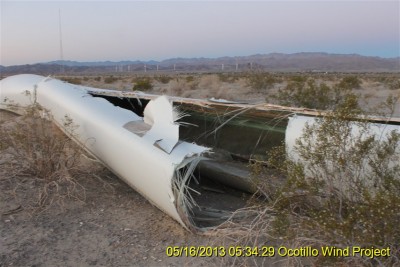
September 8, 2022 by stopthesethings 2 Comments
Like playing Where’s Waldow, wind turbines keep losing blades and their owners apparently have trouble finding them again. Which seems strange, given that these suckers are 45-70m long and weigh between 8 and 20 tonnes.
The trade euphemism for blades flying in all directions is “component liberation”, as if that abuse of the English language is meant to make wind farm neighbours or passing motorists feel any more safe and secure.
With thousands of these things being speared into the backyards of closely settled rural communities, the risk of death and serious injury, only increases.
The wind industry (which really only got off the ground in the late 1990s and still generates a trifling amount of electricity) has clocked up around 228 fatalities, – see the helpful collection of wind farm death and injury stats compiled by Scotland Against Spin all available here: https://scotlandagainstspin.org/turbine-accident-statistics/
Among the fatalities and injuries caused are those that result from vehicles being impaled by wind turbine blades or people being struck by flying chunks thereof: see our posts here and here and here and here and here.
Here’s another “component liberation” event.
Upcoming investigation: How an airborne blade exposed broader problems at PGE’s flagship wind farmOregon LiveTed Sickinger17 August 2022
In the early hours of Feb. 1, one of the spinning blades on a turbine at Portland General Electric’s Biglow Canyon wind farm in Sherman County launched into the night.
The 135-foot piece of fiberglass, wood and metal weighs more than seven tons.
It flew the full length of a football field.
A Vestas turbine launched a blade at Portland General Electric’s Biglow Canyon wind farm Feb. 1. The seven-ton blade landed along with a shower of bolts in a field
An investigation by The Oregonian/OregonLive has found that the seemingly isolated incident, which has not been publicly reported until now, is part of a pattern of maintenance problems that have undercut production at PGE’s flagship wind farm, shortchanged ratepayers and landowners, and put those who cultivate wheat under the turbines – and their cropland itself – at risk.
After the winter incident, PGE shut down all 217 turbines at the wind farm while it launched a review. The process took months, cut heavily into the project’s energy production at what is typically the windiest season of the year, and turned up numerous other problems at the facility with the potential to impact public safety, records show.
To date, PGE has refused to comment on the results of its review or say exactly what its inspections found. Oregon’s largest electricity provider has since resumed operations for most turbines at Biglow Canyon, saying they are safe.
“PGE is taking this matter very seriously as a safety incident, which is why we took swift action to shut down the turbines and are conducting a thorough and deliberate investigation, so that we can fully understand the cause of the blade failure and rectify it,” the company said in a statement. “The results of the investigation will help us determine if there are any adjustments needed to improve our operations.”
As recently as this spring and summer, dozens of the once pristine white turbines at the site were caked in oil and lubricants leaking from gearboxes and other controls housed in a box behind the rotor, suspended 265 feet in the air. That oil not only coats the machines, it is spitting into surrounding fields. Transformers have ruptured with drumbeat regularity, dumping thousands of gallons of mineral oil into the soil and causing two fires in the last 15 years.
Pieces of the turbines – hatch doors, metal disks and blade bolts – have routinely fallen off turbines and into the fields below. PGE has failed to report most of those incidents to the state, despite requirements in state rules to operate and maintain the turbines in a safe fashion, and a specific condition in its operating agreement to report any problems that could impact public safety within 72 hours.
Most exasperating to the landowners who lease their property to PGE, and something they’ve complained about for years to little avail, is all the turbine downtime. They are paid based on the wind farm’s production levels and regularly look out to see dozens of idled turbines on windy days. That’s also clean electricity that the project isn’t producing for ratepayers who are demanding and paying for it, from a utility that has pledged to eliminate its greenhouse gas emissions by 2045.
Landowners recently hired a Portland lawyer to investigate potential remedies.
“My clients are interested in one very simple thing,” said the lawyer, Michael Schultz. “They want it maintained so that their cropland is no longer being contaminated, that turbine nacelle hatch doors aren’t falling off. Put simply, they’re interested in an adequate and appropriate level of maintenance.”Oregon Live
Oh, for those keen on a round two of ‘Where’s Waldo’ – the wind industry version – here you go:
If one lands in your front yard, be sure to call its owner.
